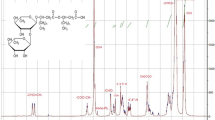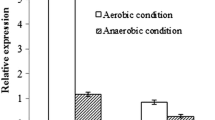Abstract
A role of rhamnolipid biosurfactant to enhance the biodegradation of hydrocarbons is known to be enhancing bacterial cell surface hydrophobicity (CSH) and adhesion of cells to hydrocarbons. Assumptions regarding the mechanism for rhamnolipid in changing CSH of Gram-negative bacteria are rhamnolipid-induced release of lipopolysaccharide (LPS) from the cell’s outer membrane and adsorption/orientation of rhamnolipid on the cell surface. In this study, the relation between cell-wall LPS or rhamnolipid content and CSH of a Pseudomonas aeruginosa bacterium subjected to rhamnolipid treatment was investigated to add insights to the mechanism. Results showed that the initial CSH was determined by the type of substrate the cells grow on and the stage of growth. For glucose-grown cells with low initial CSH and high LPS content, rhamnolipid sorption in cell wall had no discernable effect on CSH. For cells grown on glycerol with medium initial CSH and low LPS content, rhamnolipid sorption increased CSH of exponential-phase cells but decreased that of stationary-phase cells. For hexadecane-grown cells with high initial CSH and high LPS content, rhamnolipid sorption decreased CSH of both exponential-phase and stationary-phase cells. The results indicated that CSH has a better correlation to the content of rhamnolipid in the cell wall than to the content of LPS in the presence of rhamnolipid treatment and that rhamnolipid adsorption may be an important mechanism for rhamnolipid to alter CSH of P. aeruginosa.






Similar content being viewed by others
References
Abbasnezhad H, Gray M, Foght JM (2011) Influence of adhesion on aerobic biodegradation and bioremediation of liquid hydrocarbons. Appl Microbiol Biotechnol 92(4):653–675
Al-Tahhan RA, Sandrin TR, Bodour AA, Maier RM (2000) Rhamnolipid-induced removal of lipopolysaccharide from Pseudomonas aeruginosa: effect on cell surface properties and interaction with hydrophobic substrates. Appl Environ Microbiol 66(8):3262–3268
Chen G, Zhu H (2005) lux-marked Pseudomonas aeruginosa lipopolysaccharide production in the presence of rhamnolipid. Colloid Surf B 41(1):43–48
Feng W, Swift S, Singhal N (2013) Effects of surfactants on cell surface tension parameters and hydrophobicity of Pseudomonas putida 852 and Rhodococcus erythropolis 3586. Colloid Surf B 105:43–50
Fu HY, Zeng GM, Zhong H, Yuan XZ, Wang W, Huang GH, Li JB (2007) Effects of rhamnolipid on degradation of granular organic substrate from kitchen waste by a Pseudomonas aeruginosa strain. Colloid Surf B 58(2):91–97
Górna H, Ławniczak Ł, Zgoła-Grześkowiak A, Kaczorek E (2011) Differences and dynamic changes in the cell surface properties of three Pseudomonas aeruginosa strains isolated from petroleum-polluted soil as a response to various carbon sources and the external addition of rhamnolipids. Bioresour Technol 102(3):3028–3033
Gray G, Wilkinson S (1965) The effect of ethylenediaminetetra-acetic acid on the cell walls of some gram-negative bacteria. J Gen Microbiol 39(3):385–399
Zeng GM, Zhong H, Huang GH, Fu HY (2005) Physicochemical and microbiological effects of biosurfactant on the remediation of HOC-contaminated soil. Prog Nat Sci 15(7):577–585
Hancock R, Nikaido H (1978) Outer membranes of gram-negative bacteria. XIX. Isolation from Pseudomonas aeruginosa PAO1 and use in reconstitution and definition of the permeability barrier. J Bacteriol 136(1):381–390
Hazen K, Plotkin B, Klimas D (1986) Influence of growth conditions on cell surface hydrophobicity of Candida albicans and Candida glabrata. Infect Immun 54(1):269–271
Inzana T, Pichichero M (1984) Lipopolysaccharide subtypes of Haemophilus influenzae type b from an outbreak of invasive disease. J Clin Microbiol 20(2):145–150
Kaczorek E, Chrzanowski Ł, Pijanowska A, Olszanowski A (2008) Yeast and bacteria cell hydrophobicity and hydrocarbon biodegradation in the presence of natural surfactants: rhamnolipides and saponins. Bioresour Technol 99(10):4285–4291
Liu XL, Zeng GM, Tang L, Zhong H, Wang RY, Fu HY, Liu ZF, Huang HL, Zhang JC (2008) Effects of dirhamnolipid and SDS on enzyme production from Phanerochaete chrysosporium in submerged fermentation. Process Biochem 43(11):1300–1303
Liu Y, Yang SF, Li Y, Xu H, Qin L, Tay JH (2004) The influence of cell and substratum surface hydrophobicities on microbial attachment. J Biotechnol 110(3):251–256
Liu Y, Yang SF, Liu QS, Tay JH (2003) The role of cell hydrophobicity in the formation of aerobic granules. Curr Microbiol 46(4):0270–0274
Masuoka J, Hazen KC (1997) Cell wall protein mannosylation determines Candida albicans cell surface hydrophobibity. Microbiology 143(9):3015–3021
Mata-Sandoval JC, Karns J, Torrents A (1999) High-performance liquid chromatography method for the characterization of rhamnolipid mixtures produced by Pseudomonas aeruginosa UG2 on corn oil. J Chromatogr A 864(2):211–220
Nikaido H (1976) Outer membrane of Salmonella typhimurium: transmembrane diffusion of some hydrophobic substances. Biochim Biophys Acta 433(1):118–132
Norman RS, Frontera-Suau R, Morris PJ (2002) Variability in Pseudomonas aeruginosa lipopolysaccharide expression during crude oil degradation. Appl Environ Microbiol 68(10):5096–5103
Obuekwe CO, Al-Jadi ZK, Al-Saleh ES (2009) Hydrocarbon degradation in relation to cell-surface hydrophobicity among bacterial hydrocarbon degraders from petroleum-contaminated Kuwait desert environment. Int Biodeterior Biodegrad 63(3):273–279
Paria S, Khilar KC (2004) A review on experimental studies of surfactant adsorption at the hydrophilic solid–water interface. Adv Colloids Interf Sci 110(3):75–95
Park KM, So JS (2000) Altered cell surface hydrophobicity of lipopolysaccharide-deficient mutant of Bradyrhizobium japonicum. J Microbiol Methods 41(3):219–226
Prabhu Y, Phale P (2003) Biodegradation of phenanthrene by Pseudomonas sp. strain PP2: novel metabolic pathway, role of biosurfactant and cell surface hydrophobicity in hydrocarbon assimilation. Appl Microbiol Biotechnol 61(4):342–351
Sotirova A, Spasova D, Vasileva-Tonkova E, Galabova D (2009) Effects of rhamnolipid-biosurfactant on cell surface of Pseudomonas aeruginosa. Microbiol Res 164(3):297–303
Tang WW, Zeng GM, Gong JL, Liang J, Xu P, Zhang C, Huang BB (2014) Impact of humic/fulvic acid on the removal of heavy metals from aqueous solutions using nanomaterials: a review. Sci Total Environ 468:1014–1027
van Loosdrecht M, Lyklema J, Norde W, Schraa G, Zehnder A (1987) The role of bacterial cell wall hydrophobicity in adhesion. Appl Environ Microbiol 53(8):1893–1897
Warren RAJ, Ells AF, Campbell J (1960) Endogenous respiration of Pseudomonas aeruginosa. J Bacteriol 79(6):875
Weinberg J, Ribi E, Wheat R (1983) Enhancement of macrophage-mediated tumor cell killing by bacterial outer membrane proteins (porins). Infect Immun 42(1):219–223
Xu P, Zeng GM, Huang DL, Feng CL, Hu S, Zhao MH, Lai C, Wei Z, Huang C, Xie GX (2012) Use of iron oxide nanomaterials in wastewater treatment: a review. Sci Total Environ 424:1–10
Yokota S-i, Fujii N (2007) Contributions of the lipopolysaccharide outer core oligosaccharide region on the cell surface properties of Pseudomonas aeruginosa. Comp Immunol Microbiol 30(2):97–109
Yuan X, Ren F, Zeng G, Zhong H, Fu H, Liu J, Xu X (2007) Adsorption of surfactants on a Pseudomonas aeruginosa strain and the effect on cell surface lypohydrophilic property. Appl Microbiol Biotechnol 76(5):1189–1198
Zeng G, Chen M, Zeng Z (2013a) Risks of neonicotinoid pesticides. Science 340(6139):1403–1403
Zeng G, Chen M, Zeng Z (2013b) Shale gas: surface water also at risk. Nature 499(7457):154–154
Zeng G, Liu Z, Zhong H, Li J, Yuan X, Fu H, Ding Y, Wang J, Zhou M (2011) Effect of monorhamnolipid on the degradation of n-hexadecane by Candida tropicalis and the association with cell surface properties. Appl Microbiol Biotechnol 90(3):1155–1161
Zhang C, Jia L, Wang S, Qu J, Li K, Xu L, Shi Y, Yan Y (2010) Biodegradation of beta-cypermethrin by two Serratia spp. with different cell surface hydrophobicity. Bioresour Technol 101(10):3423–3429
Zhang Y, Miller RM (1992) Enhanced octadecane dispersion and biodegradation by a Pseudomonas rhamnolipid surfactant (biosurfactant). Appl Environ Microbiol 58(10):3276–3282
Zhang Y, Miller RM (1994) Effect of a Pseudomonas rhamnolipid biosurfactant on cell hydrophobicity and biodegradation of octadecane. Appl Environ Microbiol 60(6):2101–2106
Zhong H, Ming Zeng G, Yuan XZ, Yan Fu H, Huang GH, Ren FY (2007) Adsorption of dirhamnolipid on four microorganisms and the effect on cell surface hydrophobicity. Appl Microbiol Biotechnol 77(2):447–455
Zhong H, Zeng GM, Liu JX, Xu XM, Yuan XZ, Fu HY, Huang GH, Liu ZF, Ding Y (2008) Adsorption of monorhamnolipid and dirhamnolipid on two Pseudomonas aeruginosa strains and the effect on cell surface hydrophobicity. Appl Microbiol Biotechnol 79(4):671–677
Acknowledgments
The study was financially supported by the National Natural Science Foundation of China (51378190, 51039001, 50908081, 51378192, 51009063, 51308200), the Environmental Protection Technology Research Program of Hunan (2007185), the Hunan Provincial Innovation Foundation for Postgraduate (CX2009B078), and the Program for Changjiang Scholars and Innovative Research Team in University (IRT-13R17).
Author information
Authors and Affiliations
Corresponding authors
Additional information
Xiaoling Ma has the same contribution as the first author.
Rights and permissions
About this article
Cite this article
Liu, Y., Ma, X., Zeng, G. et al. Role of low-concentration monorhamnolipid in cell surface hydrophobicity of Pseudomonas aeruginosa: adsorption or lipopolysaccharide content variation. Appl Microbiol Biotechnol 98, 10231–10241 (2014). https://doi.org/10.1007/s00253-014-5957-3
Received:
Revised:
Accepted:
Published:
Issue Date:
DOI: https://doi.org/10.1007/s00253-014-5957-3




